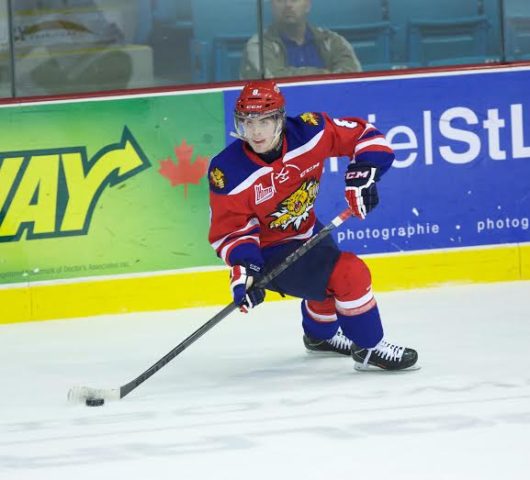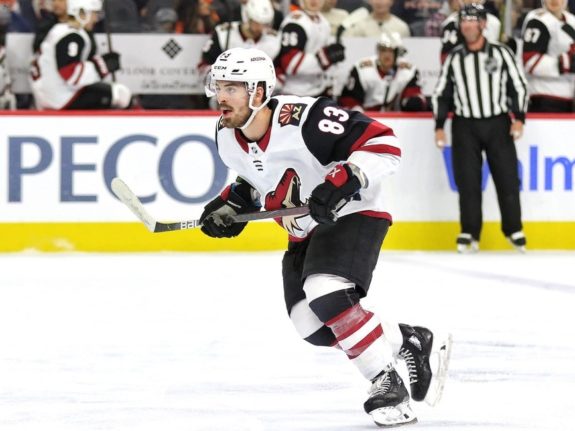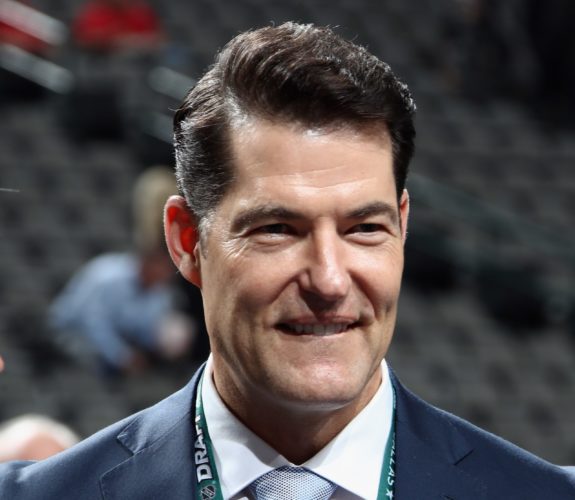Over the past seven seasons of his hockey career, Arizona Coyotes’ forward Conor Garland has had quite a ride.
As an 18-year-old, he went undrafted, likely as a result of his small 5-foot-8 size and slight 160-pound build at the time.
As a 19-year-old, he led the entire Canadian Hockey League in scoring, yet fell to the fifth round of the draft in his second go-around at the event.

By the end of his age-22 season, Garland was two years into his entry-level deal and had scored just 41 points in 110 games at the AHL level. He had collected only 13 goals on 193 shots during this span, for a dismal shooting percentage of 6.7%. His points per game average ranked 11th on his own team in 2017-18, and those who had written off the prolific QMJHL scorer as being too small, and passed on him in the draft for this reason, were being proven right.
Three years later, though, Garland finds himself as an established top-six NHL winger at age 25. His hard work has paid off, and a well-deserved pay raise is soon to come his way after 164 productive contests with the Coyotes. It was assumed prior to the start of this offseason that Garland, currently a restricted free agent, would be a key piece in Arizona for years to come, but it doesn’t appear as if this is the case, as news recently broke suggesting that the ‘Yotes have had little contact with their second-highest scoring forward when it comes to a contract extension:
The failure to get Garland re-signed to a long-term deal would be a slap in the face to a Coyotes fanbase that has been waiting a long time for an exciting, home-grown young player to come along. We’ve played lots of not-so-fun games of “what could have been” with many players in Arizona – from Danny Briere to Nikolai Khabibulin, there’s no shortage of players who went on to enjoy success with other teams after the Coyotes moved on from them too early.
Let’s not add Garland to this list.
Garland’s NHL Journey
Coyotes fans have known Garland’s name since he was drafted way back in 2015 – the eye-popping numbers he posted with the Moncton Wildcats of the Quebec Major Junior Hockey League (QMJHL) spoke for themselves, and many kept their eyes on this player as he rose through the ranks in Arizona’s development pipeline.
In 2018-19, Garland finally received his NHL shot and he quickly made a name for himself in the league. After seven scoreless games to start his career, the Scituate, MA native went on a tear, scoring 13 goals and 5 assists over the final 40 contests while playing less than 13 minutes a night for former head coach Rick Tocchet.
Perhaps his most memorable performance as a rookie came on Jan. 12, 2019, in a 3-2 Coyotes win over the Edmonton Oilers. With Arizona on a power play early in the second period, Garland, despite his small stature, was at the front of the net. He was sent to the ice by Edmonton defenseman Adam Larsson, and he got up just in time to be struck in the face by a Jordan Oesterle wrister:
The puck went into the net to give the Coyotes the lead, and, despite being bloodied on the play, Garland later returned to score the game-winner in the third period. The two-goal night earned Garland a lot of fans in Arizona, and he continued to add to his reputation by giving 100 percent effort on every single shift. No matter if Arizona trails 3-0 or leads by three goals, it’s always easy to notice the right-winger when he’s on the ice.
For his career, Garland has posted a total of 47 goals and 49 assists for 96 points in 164 games. He hasn’t had the opportunity to play a full 82-game season yet, as the previous two campaigns were shortened by COVID-19, and he didn’t make his NHL debut in 2018-19 until December. Still, we can take his per-game averages and figure out his projected 82-game pace for all three of his NHL seasons:
- 2018-19: 23 goals, 9 assists, 32 points
- 2019-20: 27 goals, 21 assists, 48 points
- 2020-21: 20 goals, 45 assists, 65 points
As can be gathered by those stat lines, Garland has been a consistent goalscorer since entering the league, but he’s also come into his own as a playmaker at the NHL level, too. After an extraordinary QMJHL career that saw him generate 183 assists over his final 129 regular-season games, he didn’t reach the 20-assist mark in any of his first four professional seasons. That changed this year, and it appears as if Garland will continue improving in the future. Players who were big-time point-producers at the lower levels of hockey don’t just “forget” how to score as they climb the ranks – they just need to adjust to the faster pace of play and increased skill of the opposition. No. 83 has done just that, and it looks like he’ll be a top-line right winger for the better part of the next decade as a result.
Garland Rumors Disappointing, but Not Surprising
Garland does it all. He creates offense. He wins puck battles along the boards. He draws penalties. He scores goals in a variety of ways. He forechecks. He backchecks. He blocks shots. He generates takeaways. He wins races to loose pucks. He’ll even go out and take the body.

All of this is why Garland has become a fan favorite in the Valley of the Sun, and it is also why it’s incomprehensible that the Coyotes haven’t signed him to a long-term extension yet. He’s a heart-and-soul player that every competitive team needs. He’s a late-round success story for a franchise that has badly struggled to either draft or develop high-end talent throughout its entire history. And, he’s deserving of wearing a letter on his chest, should captain Oliver Ekman-Larsson or alternates Phil Kessel and Niklas Hjalmarsson be moved this summer.
The failure of the Coyotes’ front office and ownership to get Garland signed to an extension would be just the latest shameful episode for a franchise that has seen its fair share of humiliation over the past 10 years. There’s absolutely no reason for this drama to be occurring, and there are plenty of avenues that the team could pursue, should it really want to get a deal done with this player.
Coyotes Must Get a Deal Done
If financial concerns are the primary issue here, which they sometimes are when it comes to this ownership group, perhaps a deal could be made with the Seattle Kraken to take on one of Arizona’s other high-priced players during the upcoming expansion draft. Center Nick Schmaltz is maddeningly inconsistent at the offensive end of the ice, yet is being paid $5.85 million for the next five years. Surely, that money would be better spent on Garland, who plays hard and makes an impact night-in and night-out, even when he isn’t scoring.

Then, there are the rumors regarding Ekman-Larsson. I’m not sure this trade would be the best option for the franchise right now, as OEL’s value is at an all-time low. Additionally, a fresh start with a new coaching staff could potentially reignite the spark that has been missing from Ekman-Larsson’s play over the past few years, but that’s a conversation for another time (and a separate column). At any rate, if the captain is moved, his departure will open up $8.25 million of salary-cap space if the Coyotes do not retain salary, and $4.125 million if the club ends up with the maximum-allowed salary retention of 50 percent.
Veteran Phil Kessel could also be on the move – his relationship with Tocchet was cited as one of the reasons for his desire to be traded to the Coyotes, and, now that Tocchet is gone, it remains to be seen if ‘Phil the Thrill’ would want to play for another coach in Arizona. In contrast to Ekman-Larsson, the Coyotes might be able to get close to market value for this player without facing the prospect of long-term salary retention, making a trade a much more realistic possibility.
Coyotes Can’t Continue on Current Course
Overall, if general manager Bill Armstrong really wants to keep Garland in a Coyotes uniform, he’ll figure out a way to do it. There are plenty of options available when it comes to moving money around to afford a new contract for No. 83, or, in the worst-case scenario, Armstrong can simply use some of the projected $31 million in cap space he’ll soon have in his pocket when the contracts of players like Jason Demers, Alex Goligoski, Niklas Hjalmarsson, Antti Raanta, and others come off of the books.

There’s absolutely no scenario in which the Coyotes’ front office, or the ownership group, for that matter, will be able to justify this move to the fanbase, and, more importantly, to the team’s current roster players. What will Garland’s departure mean for up-and-coming prospects like Barrett Hayton, Matias Maccelli, Jan Jenik, Victor Soderstrom, Ivan Prosvetov, and others? If they have similar breakout seasons and emerge as key NHLers as Garland did, they’ll likely have concerns about being similarly discarded when it comes time for the organization to reward their success with a new contract. When it comes to the fans, why should they continue to invest their time and money into a team that, should they flip Garland this summer, obviously has no interest in winning in 2021-22?
Garland did the Coyotes a favor two years ago by signing a team-friendly two-year deal with an average annual value of $775,000. The 25-year-old provided by far the best value in the NHL this year among players on standard, non-rookie contracts, producing at a rate of $19,871 per point, which was the cheapest in the league and $7,900 less than the next player on the list, Carter Verhaeghe.
Now, it’s time for Arizona to pay up and reward this player for his contributions, hard work, and effort, but they’ve shown little willingness to do so.
And that’s unacceptable.